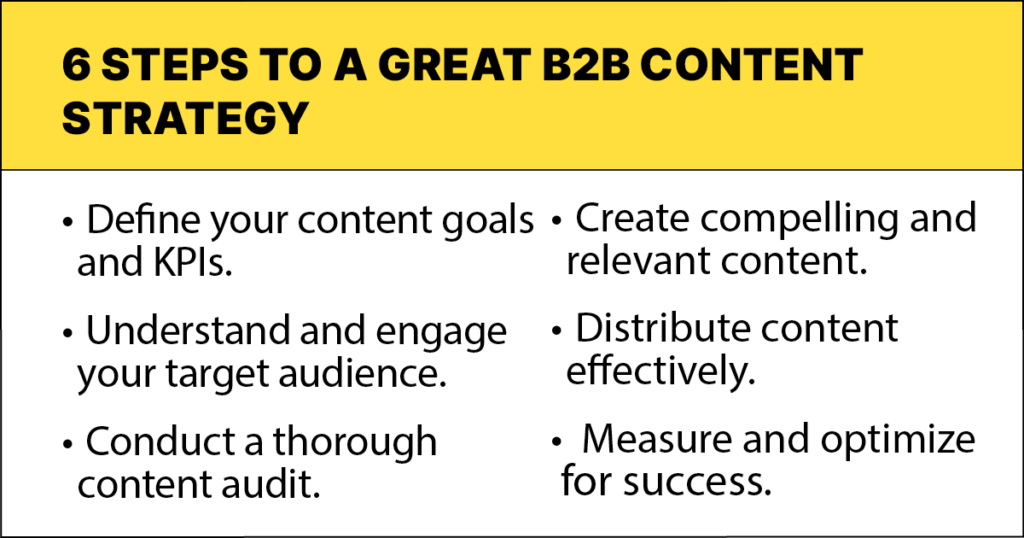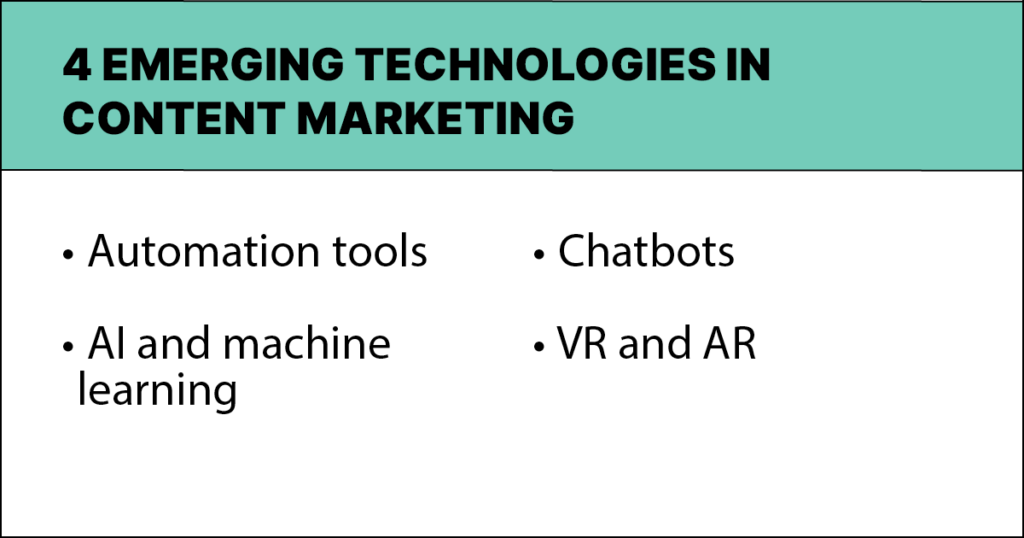Does B2B content strategy planning for your brand sit atop your to-do list? If not, it should.
A comprehensive B2B content strategy is the road map you’ll follow to realize your brand’s content marketing goals and objectives and effectively engage your target audience.
A well-planned strategy ensures that your content is relevant, timely and capable of driving desired customer actions. Without a plan, your content marketing efforts are akin to shooting in the dark. You’ll likely waste resources and miss your targets.
Think of it like this: Content is not merely a part of your strategy — it is the strategy. Let this guide serve as your template.
What Is B2B Content Strategy?
Just what is a B2B content strategy? Let’s start by defining the term.
A B2B content strategy involves planning, creating, distributing and analyzing content to meet specific business objectives. It is about creating a content plan that addresses the needs and challenges of your target audience and guides them toward solutions your business provides.
Content’s Role in B2B Marketing
Content plays a crucial role in B2B marketing. Effective content marketing provides value to the target audience, establishes the brand as a thought leader and drives engagement and conversions through strategic distribution. In essence, content connects your brand to potential customers and illustrates your brand’s value proposition.
Differences Between B2B and B2C Content Strategy
B2B content strategy planning focuses on addressing specific business needs and challenges through insights, best practices and solutions. B2C content strategy aims at engaging individual consumers, often through emotional and entertainment-driven content. Both rely on storytelling but often go about it in different ways. In many cases, B2B content marketing plans must account for a longer buying cycle and more stakeholders than B2C strategies.
Core Elements and Objectives of B2B Content Marketing
Every B2B content marketing strategy should understand the target audience, generate a content calendar to address their needs and distribute content through channels where your audience is active. The objective is to establish thought leadership, boost brand awareness, nurture customer relationships, facilitate conversions and produce content marketing ROI.
Benefits of Strategic B2B Content Planning
B2B companies can find some level of success by publishing content on an ad hoc basis, particularly if they have a compelling product or well-known evangelists. But in the long run, you need a long-term, strategic B2B content plan to help you master SEO, drive prospects closer to a buying decision and prove that your content contributed to leads, pipelines and won business.
Here are several benefits of a strategic content plan.
Brand Authority and Trust
Effective B2B content planning establishes your brand as an authority in the industry, both by reputation and in search engine rankings. By consistently delivering valuable and expert content, your brand becomes a trusted source of information. As your target audience gets to know you, they’re more likely to consider furthering the relationship or share your content (and brand) with others.
Lead Generation and Nurturing
Strategic content planning is pivotal for generating and nurturing leads. By creating content that addresses your target audience’s specific needs and pain points, you attract qualified leads and nurture them through the sales funnel toward conversion.
Customer Engagement and Education
Content strategy planning enables you to create educational content that informs people about industry trends, best practices, and your products and services. Done well, your content improves prospect and customer engagement and empowers them to make informed decisions.
SEO and Online Presence
Strategic content contributes to search engine optimization (SEO) efforts, improving your brand’s search engine visibility and driving organic traffic to your website. By optimizing content for relevant keywords, you increase the likelihood of being found by potential clients.
Case Study: IBM’s ‘Smarter Planet’ Campaign Highlights Tangible Benefits
IBM’s “Smarter Planet” campaign used content to raise awareness about sustainability initiatives, with a focus on engaging stories from customers who benefitted from IBM solutions.
IBM published SEO-optimized blog posts, along with videos and podcasts. It promoted the campaign with targeted advertising, events and PR activities that increased reach and engagement across multiple audiences and markets.
The campaign delivered measurable engagement — a 259% increase in website traffic, increased brand recognition and social mentions (over 8 million) and improved sentiment among stakeholders (+42%).
That engagement also contributed to business success. Within three years of launching Smarter Planet, IBM achieved a 16-year revenue high.
Challenges of B2B Content Strategy
Every content strategy plan requires identifying and addressing challenges and potential roadblocks. Here are some of the high-level challenges you’ll likely encounter during content planning.
- Identifying and engaging the target audience: The starting point for many B2B content strategy sessions is identifying the target audience. Only when you know who you’re addressing can you tell meaningful stories and focus on what you want the audience to do next.
- Aligning content with sales and marketing goals: Ensuring your content strategy aligns with your sales and marketing goals is pivotal. Your content should drive engagement and facilitate lead generation and conversions, contributing to overall business objectives. Alignment also means being consistent in content themes, tone, style and messaging so you align with brand values and business objectives.
- Overcoming obstacles in the digital landscape: Industries, workplace technologies and even what jobs people do are evolving quickly. Your content strategy won’t be immune to evolving trends, changing algorithms and shifting audience preferences.
Here are some ways you can address these challenges in your content strategy.
Identifying and Engaging the Target Audience
- Leverage personalization: Use data analytics to personalize content and target it toward different audience segments. Look at data from other parts of the company, such as your CRM, to guide you.
- Engage through multiple channels: Identify and utilize the channels where your target audience is most active. While most B2B brands will rely on SEO content hosted on their website, the other channels they turn to will depend on their needs and market conditions.
- Get audience feedback: Regularly gather and analyze feedback from your audience to ensure content relevance. Engagement and conversion data can help you identify content that particularly resonates.
- Conduct a competitive analysis: Keep an eye on competitors’ content strategies to safeguard that your content remains competitive and relevant.
Aligning Content with Sales and Marketing Goals
- Embrace collaboration: Facilitate regular communication and collaboration between sales and marketing teams to secure alignment in goals and strategies.
- Use strong CTAs. Implement clear and compelling calls to action (CTAs) to guide prospects through the sales funnel. Even informational content can move the reader to the next step, such as a webinar or an invitation to join your email list.
Overcoming Obstacles in the Digital Landscape
- Adapt to platform algorithms. Stay updated with changes in search engine and social network algorithms. Modify your content strategy accordingly to ensure visibility and engagement.
- Employ visual and interactive content. Videos, images and infographics are just some of the ways to capture attention and improve engagement, especially to promote content on more visual platforms such as Instagram, Pinterest or YouTube.
Crafting Your B2B Content Strategy: A Step-by-Step Guide
Steering toward solutions, let’s outline the practical steps you should follow in crafting a powerful B2B content strategy.
Define Your Goals and KPIs
- Align with business objectives: Your content strategy shouldn’t operate in a vacuum. Begin by defining clear content goals that align with your overall business objectives. For instance, if your business goal is to increase brand market penetration, your content should aim to raise brand awareness and reach.
- Set measurable KPIs: Establish key performance indicators (KPIs) to measure your content strategy’s effectiveness and drive desired outcomes. These could range from website traffic, social media engagement and lead generation to conversion rates. KPIs make your goals quantifiable, offering insights for strategy refinement.
Understand Your Target Audience
- Create buyer personas: Broad audience categorizations will no longer suffice in today’s hyper-personalization era. Develop detailed buyer personas to understand your audience’s needs, challenges and decision-making processes. Make sure to update personas over time, especially as buyers become customers. As Marketing Interactions Inc. CEO Ardath Albee says, “The problems and goals are now different, as they’ve solved the original problem by buying your solution. Also, in B2B, the original buyer often isn’t the same person as the renewal or expansion buyer.”
- Map the buyer’s journey: After defining your buyer personas, understand their journey through the awareness, consideration and decision stages. Mapping your strategy to their journey ensures your content meets prospective buyers at every stage.
Conduct a Content Audit and Analysis
- Evaluate existing content: Content audits help you understand the current state of your content so you aren’t repeating mistakes or duplicating successful content, especially regarding SEO. Identify, categorize and evaluate every piece of content’s performance against your KPIs. Which pieces are performing well? Which ones fail to deliver? The answers to these questions are crucial in planning your future content.
- Identify gaps and opportunities: Analyze existing content to identify gaps and explore opportunities for addressing your audience’s unmet needs and potential areas of interest. This is especially important for emerging topics, such as a new industry innovation or something transformative like generative AI.
Start Planning and Creating Content
- Develop a content calendar: Your content calendar presents a holistic view of all the content ideas your team has and how you’ve prioritized them. It accounts for publishing frequency, topics, channels and formats — all while ensuring consistency and strategic alignment with key business events and cycles. By centralizing your content marketing plan, you confirm that your team is collectively pursuing marketing and business goals regardless of what type of content is in progress.
- Prioritize quality and relevance: Even for brands that push out dozens of pieces of content across channels each week, you still want to prioritize quality and relevance over volume. Invest in data-driven keyword research and audience insights to create content that satisfies user intent. Make sure your thought leadership actually has something to say. In all cases, avoid generic, thin content that fails to provide valuable solutions or engage your audience.
Distribute and Promote Content
- Select appropriate channels: To paraphrase a line from “Field of Dreams,” just because you build it doesn’t mean they will come. Creating engaging content is only one part of the plan. How and where you distribute your work will determine its impact. Identify and utilize the most effective channels for content distribution to reach your target audience. Evaluate which organic channels — including SEO, email newsletters and social media — are best suited for your content formats and target audience.
- Leverage paid advertising: Maximize your content’s potential by combining organic reach with paid advertising, such as sponsored posts, pay-per-click (PPC) ads or retargeting. Remember, content marketing and PPC don’t have to be enemies.
Measure and Optimize
- Analyze performance data: Using your KPIs, evaluate the performance of your content across channels with tools such as Google Analytics, Semush and Moz. These tools give insights into traffic sources, user demographics, session lengths, engagement rates and conversion paths.
Make data-driven adjustments: Use data-driven content marketing insights to optimize your strategy over time, including adjustments to your content calendar, channels or even target audience. Regular measurement and iterative optimization foster long-term success, no matter what happens with audience preferences or market dynamics.

Software Tools for Your B2B Content Strategy
While content strategy is still a human skill, the tools and technologies at your disposal play a big role in how successful your content strategy is — and how much work creating it takes. Here are some of the software tools you’ll need to lean on.
Content Management Systems
Implementing a robust CMS like WordPress, HubSpot or Drupal will simplify your content creation and management processes. These platforms give you control over content development, workflow management and performance tracking.
SEO and Analytics Tools
SEO and analytics tools such as Ahrefs, Semrush or Buzzsumo help you assess performance, optimize your content for SEO, perform competitor analysis and track industry trends. Utilize these tools to conduct informed keyword research, optimize on-page content elements and track rankings. Google Analytics and similar tools will give you deeper insights into your site traffic, including time on page.
CRM Software
CRM software such as Salesforce or HubSpot drive data-backed content marketing initiatives by leveraging historical customer data and other proprietary data to understand and anticipate your audience’s needs. A CRM system streamlines customer communication, tracks lead progress and enhances nurturing efforts.
Social Media Management Tools
Social media management platforms, such as Hootsuite, Buffer, CoSchedule or Sprout Social, facilitate the scheduling and posting of content across various social channels, saving your team’s time and energy. These tools provide analytics, helping you understand which content resonates well with your followers. They also allow for seamless collaboration among your social media team members.
Email Marketing Platforms
Email continues to deliver solid returns in B2B marketing. Platforms such as Mailchimp, Campaign Monitor or ConvertKit offer a comprehensive suite of email marketing tools, including contact management, template builder and segmentation capabilities to performance views.
What’s Next in B2B Content Marketing Technology?
Technology is an integral part of an impactful B2B content strategy, and it’s always evolving. Here is a representative sampling of some of the most popular emerging technologies and tools.
Automation Tools
Automate repetitive tasks to give your team more time to focus on strategic and creative elements. Automation is found in almost every content marketing tool, but tools such as HubSpot, Salesforce Pardot or Marketo are particularly designed to streamline workflows while maintaining consistent brand voice and messaging.
AI and Machine Learning
Artificial intelligence (AI) and machine learning (ML) are similarly being integrated with most modern content marketing tools today, as well as a host of other tech used by marketers, such as Grammarly, Microsoft 365 and AI assistants. Integrate AI and ML into content planning to save time and take advantage of predictive analytics, sentiment analysis and personalized content recommendations.
Chatbots
Utilize chatbots in your website to facilitate real-time engagement and deliver immediate responses to audience inquiries. This can enhance the user experience and offer an interactive form of a CTA for readers as they navigate through your website. You can also use AI-powered chatbots to answer questions, such as we do at Managing Editor with our content marketing chatbot.
VR and AR
Explore using virtual reality and augmented reality to create immersive and interactive content experiences. This can differentiate your brand and create a memorable user experience that also shares your brand’s value.

Additional Resources
B2B content strategy is an ongoing process, and no matter what your experience level, there’s always more to learn. Here are some of the resources I recommend:
Books and Online Courses
- “Everybody Writes,” by Ann Handley, navigates the process of creating stellar online content tailored for content marketers and writers.
- “Killing Marketing,” by Joe Pulizzi and Robert Rose, explores how companies can transform their marketing strategies to drive business revenue.
- “Epic Content Marketing,” by Joe Pulizzi and Brian Piper, explains how to draw prospects and customers in by creating information and content they want to engage with.
- HubSpot Academy offers many free courses on content marketing, including strategy, SEO and social media marketing.
- Coursera has courses related to content marketing from universities and colleges worldwide.
- LinkedIn Learning features a range of courses covering content marketing aspects, including writing, SEO and analytics.
- Udemy includes many courses on various aspects of content marketing and related domains.
Forums, Communities and Events
- Content Marketing Institute has a wealth of resources, articles and forums on various aspects of content marketing.
- Reddit’s Content Marketing Community is a space for content marketers to discuss, share and learn about the latest in the field.
- LinkedIn Groups lists a range of content marketing-related groups for networking and discussion with fellow marketers.
- Content Marketing World brings together content marketing professionals from across the globe, offering insights, workshops and networking opportunities.
- Inbound, hosted by HubSpot, is an annual event covering the spectrum of marketing, including content marketing.
- B2B Marketing Expo offers insights into the latest tools, technologies and strategies in B2B marketing.
Get Started With Your B2B Content Marketing Plan
You’ve learned about the B2B content strategy journey, including what B2B content strategy means, its significance and benefits, and how to take a structured approach to planning strategy. Your path from here involves applying these insights, engaging in continuous learning and actively participating in the vibrant community of content marketers.
To get more expert insights and helpful tips like these, subscribe to Managing Editor’s weekly newsletter.






